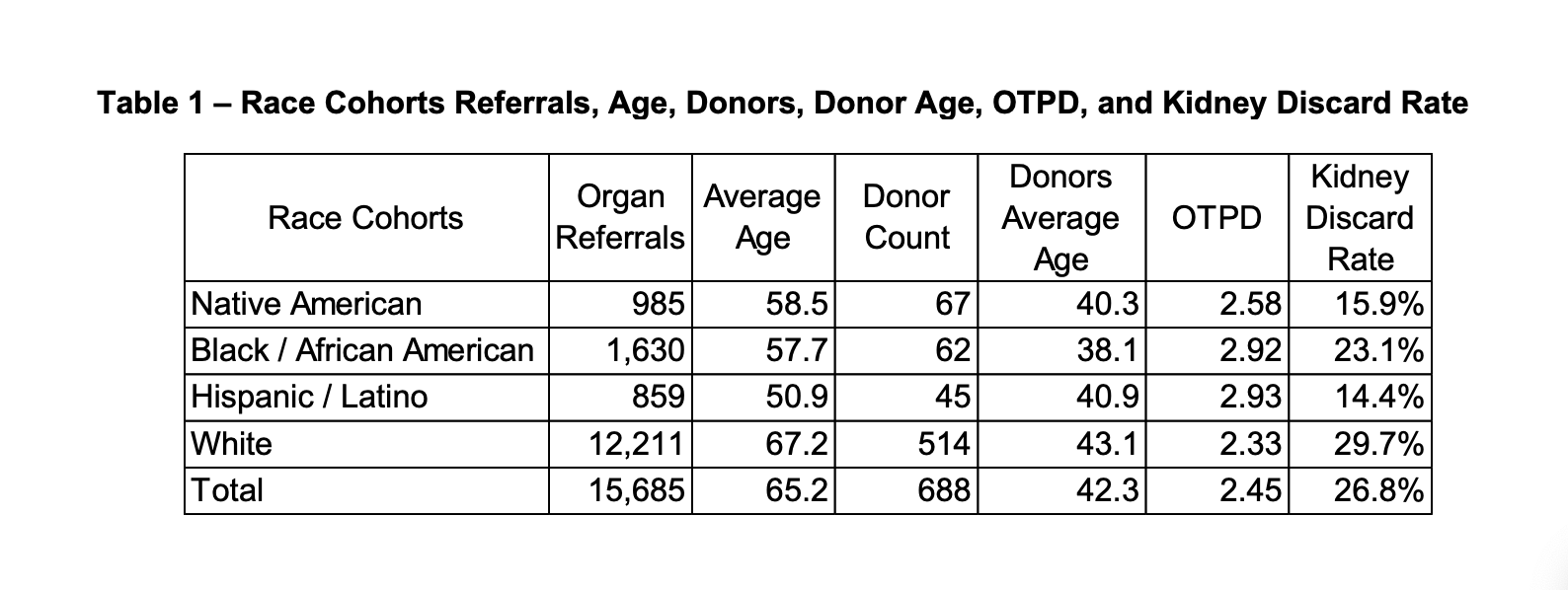Organ donor outcomes in the hispanic/latino population: a single OPO review
Jeff G Mathews1, Rachael E Ketcham1, Clint A Hostetler1, Jason S Morton1, Kimberly A Gillespie1, Kathryn J Smith1, Jeffrey P. Orlowski1.
1LifeShare Network, Inc., Oklahoma City, OK, United States
Purpose: The primary goal of this study was to investigate potential differences in organ donor outcomes among different racial cohorts within one OPO’s donation service area (DSA). We sought to determine whether differences exist in the average age, organs transplanted per donor (OTPD), and kidney discard rates between Hispanic/Latino donors, and other race cohorts (White, Black, Native American).
Methods: Data were collected and analyzed from our internal electronic medical records system and Oklahoma census data. We examined three years (2020 through 2022) with a total of 15,685 organ referrals, including 12,211 White, 1,630 Black, 985 Native American, and 859 Hispanic referrals. One-way ANOVA was used to compare the average age of organ donor (ventilated) referrals among different race cohorts. Chi-squared testing was employed to compare the proportions of kidney discards among each race groups’ donors recovered.
Results: Hispanic referrals accounted for 5.5% of referrals during this time, though they represent 11.7% of Oklahoma’s general population. The average age of Hispanic referrals was 16.3 years younger than the oldest cohort (White). The one-way ANOVA revealed significant differences in average age between racial groups (p < 0.05), with the Hispanic cohort being significantly younger than both White and Black cohorts. The difference in average ages between Hispanic and White groups narrows to 2.2 years when considering only recovered organ donors, and the Black donor cohort is the youngest on average (38.1). Hispanic donors made up 45 (6.5%) of 688 donors during the study period and had the highest OTPD (2.93) and the lowest kidney discard rate (14.4%) among all cohorts (Table 1).

Additionally, the Chi-squared test indicated significant differences in kidney discard rates among the race groups (p = 0.025). The Hispanic donor cohort consisted of 24 brain dead donors and 21 donations after circulatory death (DCD) donors. Of the kidneys recovered from Hispanic DCD donors, only 11.9% were discarded. The next lowest DCD kidney discard rate observed is among the Native American cohort (24.1%), with the highest being the White cohort (37.7%).
Conclusions: Our findings suggest that the Hispanic/Latino potential donor population within our DSA may have better organ donation outcomes in terms of higher OTPD, and lower kidney discard rates. Further research is needed to understand factors (such as younger average age) that may contribute to these improved outcomes, and to determine strategies which enhance organ donor opportunities with this group. Given these results, an increased focus on improving authorization rates within the Hispanic/Latino community may lead to improved organ transplantation success in our DSA.